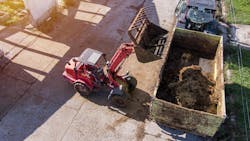Maine ENR committee supports emergency bill LD 297 for temporary biosolids disposal solution
The committee charged with protecting Maine’s air and water quality, natural resources, and other key environmental issues, voted 10 to 1 in favor of supporting LD 297, an emergency bill which allows Maine to continue accepting bulky waste from out of state. The material is used in Maine landfills to stabilize municipal biosolids. While seemingly contrary to the Environment and Natural Resource (ENR) Committee’s charge, lawmakers say it’s a ‘necessary, but temporary solution’ until the state can define a holistic waste management plan, specifically for biosolids.
“I am a passionate protector of Maine’s natural resources and the environment, and while this bill seems ominous on the surface, its passage is necessary to avoid worse environmental and public health crises,” said Bill Bridgeo (D-Augusta) in a press release, who sponsored LD 297. Bridgeo sits on the ENR and the Inland Fisheries and Wildlife committees.
In 2022, the Juniper Ridge landfill in Old Town suddenly closed due to capacity constraints, leaving dozens of public wastewater utilities with nowhere to dispose of biosolids and put them dangerously close to overflowing untreated materials into Maine’s watersheds, rivers, and oceans. The landfills’ instability led to a near crisis in a 24 hour period.
“That was a true public health and environmental crisis that Maine narrowly avoided and we simply cannot risk that again,” Bridgeo said in a press release.
Since Maine passed its landmark PFAS legislation in 2022, making it the first state in the nation to ban land application of biosolids, landfills became the only place to dispose of biosolids for the wastewater industry. Between 2018 and 2022, the amount of municipal solid waste increased by 47-percent into Maine landfills, creating ongoing stability and capacity issues. The landfill infrastructure is not designed to accept wet waste such as biosolids – oversized items are used to provide supportive infrastructure to contain the biosolids.
“Maine wastewater facilities are facing a continued crisis related to biosolids management,” said Dan Marks, Falmouth Wastewater superintendent and government affairs liaison for Maine Water Environment Association (MeWEA), in a press release. “None of us in wastewater treatment want to be disposing of biosolids at the landfill – it adds to the state’s waste disposal capacity issues, increases carbon in the atmosphere, and puts us at odds with the Penobscot Nation. LD 297 allows essential time for Maine to continue its work on refining state-owned landfill operations and exploring alternative disposal options.”
MeWEA is Maine’s wastewater association representing 650 districts, nonprofits, regulators and businesses.
“Bangor, like the rest of the state, still faces an uncertain future for biosolids disposal. Our city has been actively engaged with the Department of Environmental Protection and environmental organizations throughout the nation to identify solutions for biosolids management, but we need more time,” said Amanda Smith, director of water quality for the City of Bangor, in a press release.
In an effort to create sustainable, long-term solutions to biosolids management, a study was funded by the MDEP and conducted by the environmental engineering firm, Brown & Caldwell in 2024. The report highlights high priority recommendations for Maine policy makers to consider: adopt federal biosolids PFAS limits; create a capital funding platform to facilitate technology and pilot programs that reduce biosolid mass at a regional level; expand capacity at Juniper Ridge; and conduct an independent study to explore new treatment processes to inform future legislation.
Maine’s PFAS legislation is an unfunded mandate with the financial and logistical burden for biosolid disposal solely borne by Maine’s wastewater industry. Since 2022, most districts have been actively working to identify grants and issue bonds to invest in new technologies that lessen the impact to landfills and ratepayers, and many are exploring the feasibility of a regional treatment facility.
The majority of ENR committee members, Maine Water Environment Association (MeWEA), and Maine Department of Environmental Protection (DEP) all recommend that the full legislature pass LD 297 this June, according to a press release. It requires a two-thirds passage.
